Asian Development Outlook- April 2025
<p>Weak consumption in the People’s Republic of China will partly offset robust domestic demand in South Asia. Disinflation is expected to continue, driven by lower food and energy prices, along
<p>Weak consumption in the People’s Republic of China will partly offset robust domestic demand in South Asia. Disinflation is expected to continue, driven by lower food and energy prices, along
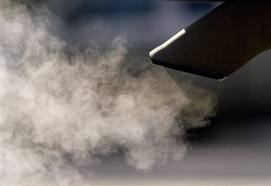
<div style="text-align: center;"> <img alt="" src="http://www.indiaenvironmentportal.org.in/files/country/bangladesh/airquality_hl.jpg" /></div> <p class="rtejustify">Bangladesh is among the least developed agrarian nations in the region, although since its creation in 1971 there has been some growth in its industrial sector. Air pollution and congestion has emerged as a leading concern, especially in major urban areas like Dhaka, with its large fleet of diesel-powerd vehicles. The problem is exacerbated by unplanned industrial expansion and poor transport infrastructure.</p>
<p><span style="font-size:14px;"><strong>Fisheries - Shrimp Cultivation</strong></span></p> <p><img alt="Fisheries" src="http://www.indiaenvironmentportal.org.in/files/country/bangladesh/fisheries_hl.jpg" style="width: 530px; height: 300px;" /></p> <p>Shrimp cultivation began in Bangladesh in the mid-1970s when exports totaled 4.7 million dollars a year.</p> <p>Until the global economic crisis, it was a 534-million-dollar-a-year business, with 42,000 tons of exports, mainly to the United States and Europe. After the garment industry, shrimp production ranks second in Bangladesh in terms of the sector’s ability to earn foreign exchange. Not only does this crop earn valuable foreign exchange, but the sector also employs significant numbers of rural workers and provides a livelihood for households throughout much of Bangladesh. A study by USAID estimates that as many as 1.2 million people may be directly involved in shrimp production with an additional 4.8 million household members supported by the industry.</p>

<p><span style="font-size:14px;"><strong>Rain Water Harvesting</strong></span></p> <p><span style="font-size:14px;"><strong><img alt="Rain Water Harvesting-Bangladesh" src="http://www.indiaenvironmentportal.org.in/files/country/bangladesh/rainwater_harvesting_hl.jpg" style="width: 525px; height: 297px;" /></strong></span></p> <p>Rainwater harvesting is one of the feasible options of fresh water sources in the coastal areas of Bangladesh and recently a lot of initiatives and programme were undertaken to promote and install rainwater harvesting systems both in the coastal and arsenic affected areas in Bangladesh. Moreover, every year the country is also blessed with ample rain. The average annual rainfall in Bangladesh is about 2200 mm, seventy-five percent of it occurs between May and September.</p>

<p><span style="font-size:14px;"><strong>Wastewater Treatment</strong></span></p> <p><img alt="Wastewater Treatment" src="http://www.indiaenvironmentportal.org.in/files/country/bangladesh/wastewater_treatment_hl" style="width: 530px; height: 300px;" /></p> <p>Increasing urbanisation and water usage has resulted in a proliferation of waterborne sanitation in Bangladesh. The majority of infrastructure projects focus on the provision of sanitation, but management of residual wastes is generally not given sufficient consideration.</p> <p>For instance, according to <a href="http://www.wssinfo.org/documents-links/documents/?tx_displaycontroller%5Bcategory%5D=&tx_displaycontroller%5Byear%5D=&tx_displaycontroller%5Bregion%5D=UNICEF:8&tx_displaycontroller%5Bsearch_word%5D=&tx_displaycontroller%5Btype%5D=country_files">Joint Monitoring Programme</a> by WHO and UNICEF in 2006, 51% of urban areas had improved sanitation facilities and only 7% urban areas had sewerage connection. In addition, only 32% of the rural population was using improved sanitation in 2006. As a result, many urban dwellers remain unserved with basic sanitation and the vast majority of wastewater and septage is discharged without any form of treatment into rivers and water bodies, seriously polluting water resources and causing a diversity of economic impacts.</p>
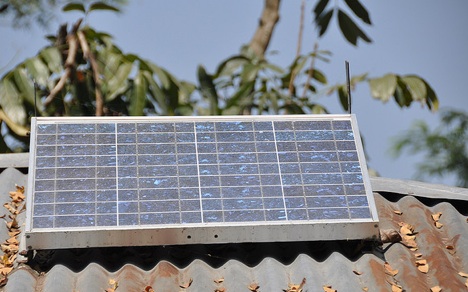
<p><span style="font-size:14px;"><strong>Solar Energy</strong></span></p> <p><img alt="Solar Energy" src="http://www.indiaenvironmentportal.org.in/files/country/bangladesh/solar_hl.jpg" style="width: 530px; height: 300px;" /></p> <p>In Bangladesh 60% of the population do not have access to the power grid. The country only produces 3500-4200 MW of electricity against a daily demand for 4000-5200 MW on average, according to official estimates. Solar energy is an ideal solution as it can provide gridless power and is totally clean in terms of pollution and health hazards. Since it saves money on constructing electricity transmission lines, it’s economical as well.</p>
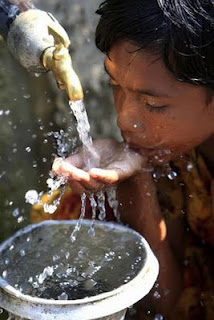
<p><span style="font-size:14px;"><strong>Arsenic Contamination</strong></span></p> <p><img alt="Arsenic Contamination" src="http://www.indiaenvironmentportal.org.in/files/country/bangladesh/arsenic_hl.jpg" style="width: 530px; height: 300px; border-width: 2px; border-style: solid;" /></p> <p>In the early 1970s, most people living in the countryside relied on surface water -- ponds, or rivers -- to meet their drinking water needs. As a result diseases due to bacteria-contaminated water, such as diarrhoea, dysentery and cholera were extremely widespread. To tackle this problem, and the related problem of drinking water, the government switched to a policy of tapping groundwater. The government began providing villages with tubewells and handpumps, with aid from such organisations as the United Nations Children's Fund (UNICEF) and the World Bank:UNICEF initiated the programme and paid for the first 900,000 tubewells along with its co-sponsor.</p>
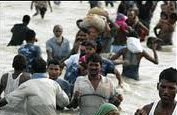
<p><span style="font-size:14px;"><strong>Glacial lake outburst flood</strong></span></p> <p><img alt="" src="http://www.indiaenvironmentportal.org.in/files/country/nepal/floods_hl.jpg" style="border-width: 2px; border-style: solid;" /></p> <p>The acronym GLOF is used for glacier floods caused by the drainage of naturally dammed lakes in the glacier, on or at the margin of glaciers. Glacial lakes form when a glacier retreats, leaving the debris mass at the end of the glacier – the end moraine – exposed.</p>

<p><span style="font-size:14px;"><strong>Bagmati River</strong></span></p> <p><img alt="" src="http://www.indiaenvironmentportal.org.in/files/country/nepal/bagmati_hl.jpg" style="border-width: 2px; border-style: solid;" /></p> <p>The Bagmati Action Plan is the latest attempt to heal the river system, from its origins in the Shivapuri hills to Chouva where it leaves the valley. It was launched in 2008 for the period 2009-14, and proposes a budget of close to 15 billion Nepalese rupees spread over five years (in comparison, in 2008 – 2009, the total allocated for the Bagmati and its tributaries was Rs. 1,394.24 million).</p>
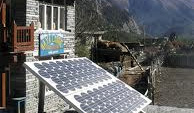
<p><span style="font-size:14px;"><strong>Renewable Energy</strong></span></p> <p><img alt="" src="http://www.indiaenvironmentportal.org.in/files/country/nepal/biogas_hl.jpg" style="border-width: 2px; border-style: solid;" /></p> <p>The major energy resource base in Nepal consists of biomass, hydroelectricity, petroleum products, natural gas, and coal reserves. Among the entire energy resource base, it is evident that biomass is the dominant resource base of the country with respect to its utilization. Biomass provided 86% of the total energy consumption, petroleum 9%, which is mainly consumed by urban areas, electricity only 2% and renewable 1% of the total energy consumption.</p>